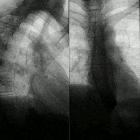gluteal injection site granulomas





Gluteal injection site granulomas are a very common finding on CT and plain radiographs. They occur as a result of subcutaneous (i.e. intralipomatous) rather than intramuscular injection of drugs, which results in granuloma formation and cause localized fat necrosis, scar formation and dystrophic calcification. Once familiar with the entity they rarely pose any diagnostic confusion.
Pathology
Fat necrosis occurs, which can liquefy. This cavity is surrounded by fibrous tissue and reactive inflammatory cells (lymphocytes, foamy histiocytes, and giant cells). Capillary growth can be prominent. Dystrophic calcification can eventually occur.
Radiographic features
CT
Usually seen as well-defined small nodules that often contain calcification.
MRI
Typical signal characteristics include:
- T1: hypointense
- T2
- the appearance depends on the temporal evolution of the granuloma
- T2 hyperintense if the reaction is inflammatory
- T2 hypointense if the reaction is fibrous
- the appearance depends on the temporal evolution of the granuloma
Nuclear medicine
PET-CT
They have been reported to be metabolically active on FDG-PET .
Differential diagnosis
The differential depends on whether or not the granuloma is calcified.
Non-calcified
Calcified
- parasitic infection
- primary bone-forming tumor
- osteosarcoma
- tumor necrosis
- autoimmune
- trauma
Siehe auch:

 Assoziationen und Differentialdiagnosen zu gluteal injection site granulomas:
Assoziationen und Differentialdiagnosen zu gluteal injection site granulomas:



